(6) The Carbon Cycle
1/43
There's no tags or description
Looks like no tags are added yet.
Name | Mastery | Learn | Test | Matching | Spaced |
|---|
No study sessions yet.
44 Terms
The Carbon Cycle
the series of processes by which carbon compounds are interconnected in the environment
involves the fixation of carbon dioxide into plants by photosynthesis + its return to the atmosphere through respiration, the decay of dead organisms, and the burning of fossil fuels

The major stores of carbon
the lithosphere
the hydrosphere
the atmosphere
the biosphere
measure of carbon
gigatonnes of carbon (GtC)
measures amount of carbon within a store
the lithosphere as a carbon store
... crust and upper section of the mantle
... uppermost part reacts with the hydrosphere, biosphere, and atmosphere to form soil
(also called the pedosphere)
Carbon is stored as...
· marine sediments and sedimentary rocks (100 million GtC)
· soil organic content (1500 GtC)
· fossil fuels (4100 GtC)
· peat (250 GtC)
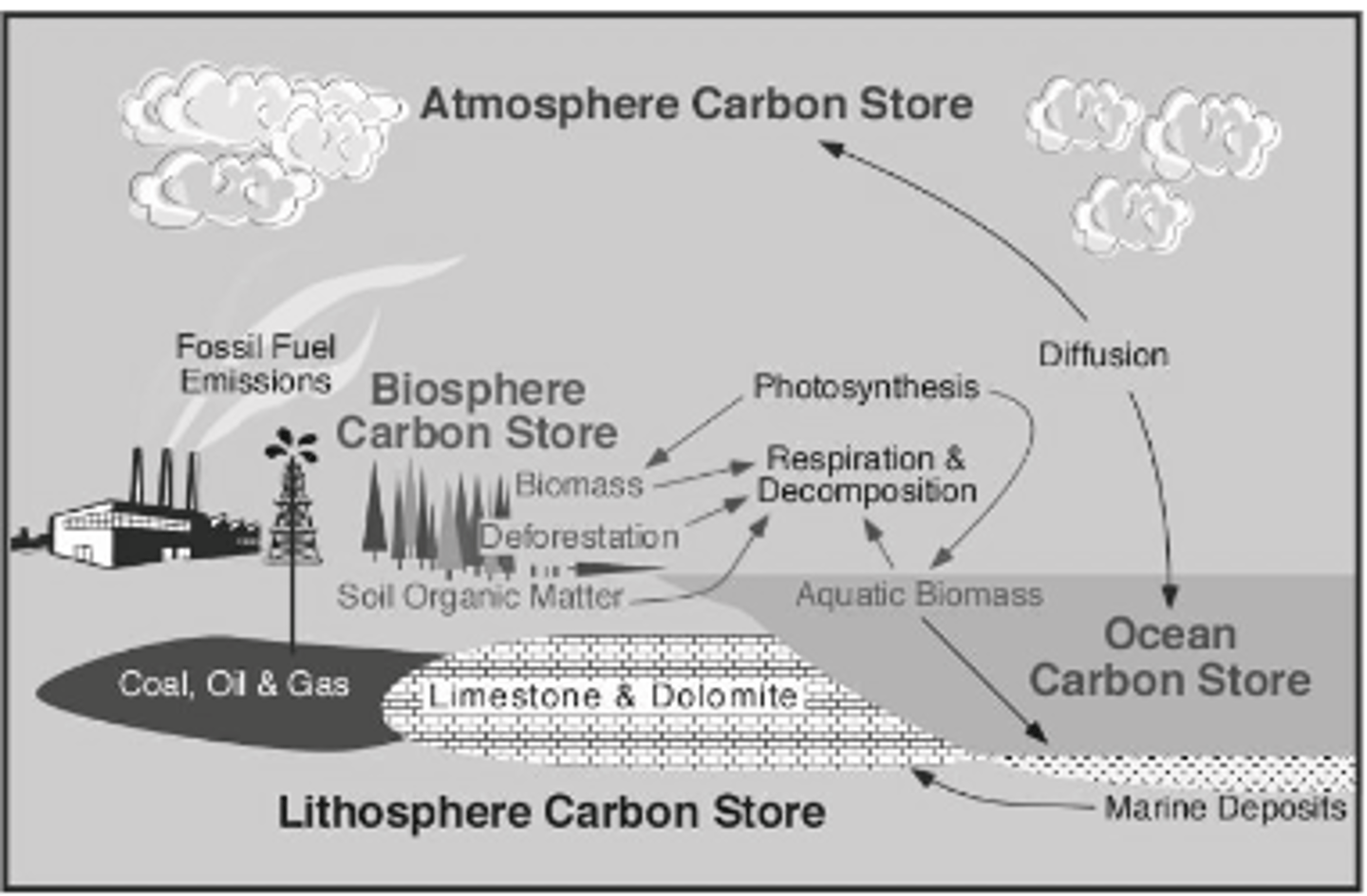
the hydropshere as a carbon store
results of Global Ocean Data Analysis Project (GLODAP)
Carbon is stored...
· ocean surface (EUPHOTIC ZONE) where sunlight can penetrate allowing photosynthesis (900 GtC)
· the twilight and midnight zone (37000 GtC)
· living marine organisms (30 GtC)
· when marine organisms die, they sink into deep water and decay into carbon rich sediments
... these will form sedimentary rocks over millions of years
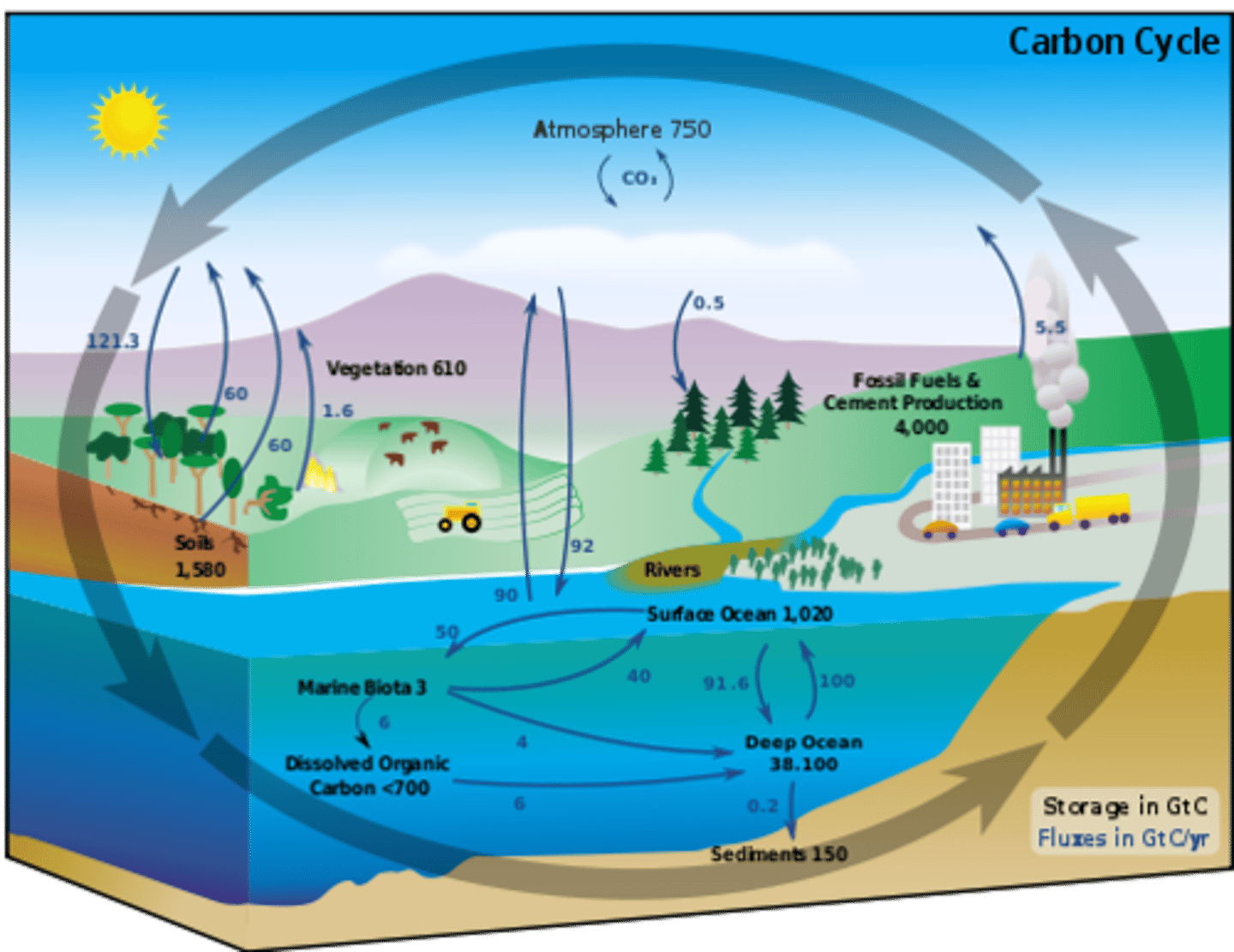
the atmosphere as a carbon store
atmospheric CO2 levels have varied a great deal in the past
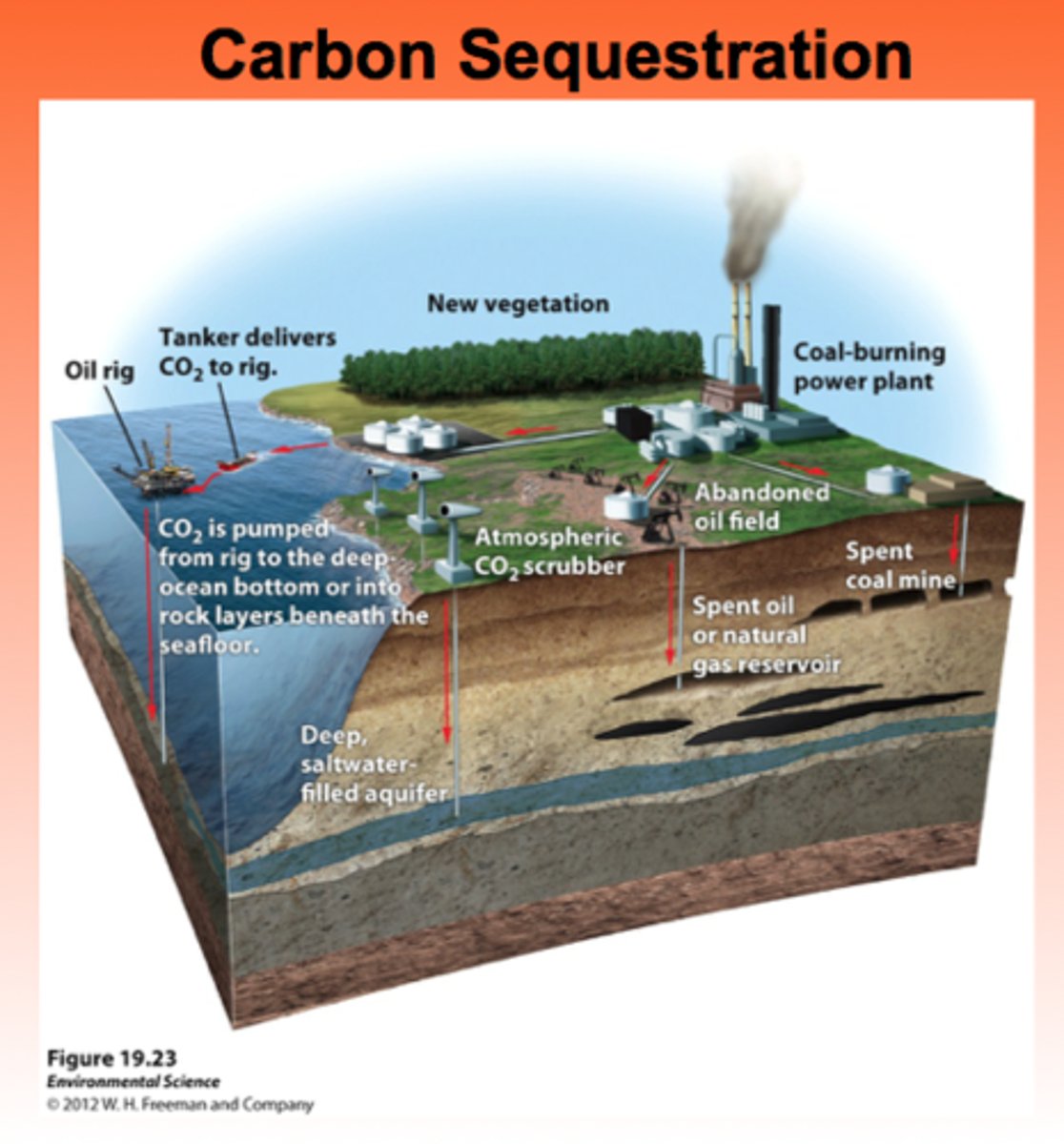
the biosphere as a carbon store
· living vegetation (19% of all carbon is the biosphere)
· plant litter
· soil humus
· peat (accumulation of partially decayed organic matter in anaerobic marsh environment)
· animals (small store but dynamic and important and flow of carbon + food chains)
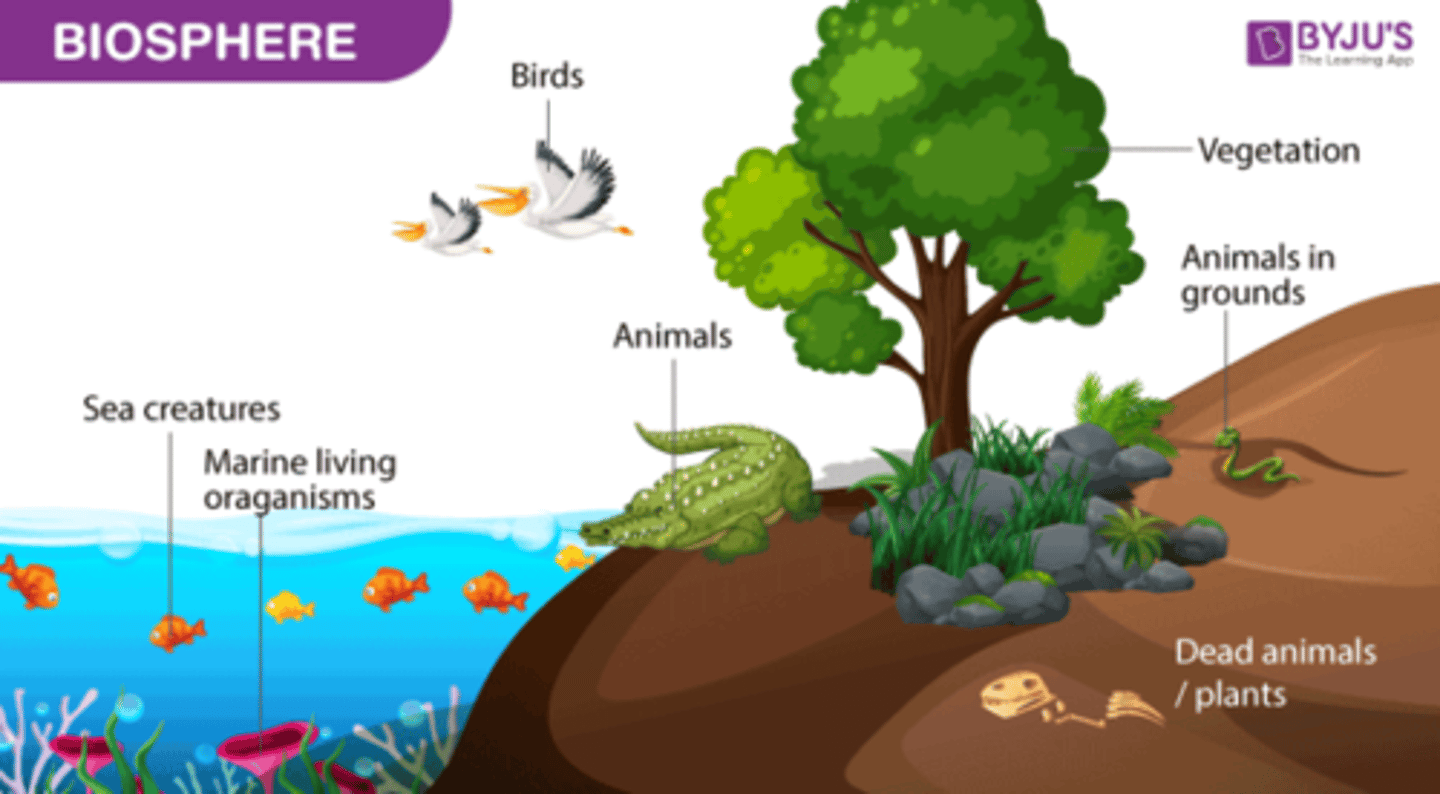
carbon + life on earth
96% of living matter consists of carbon, hydrogen, and oxygen
... carbon is essential for life on earth
the importance of carbon
1. carbon is one of the most chemically versatile of all the elements
2. carbon forms more compounds than any other element and scientists predict that there are more than 10 million different carbon compounds in existence on earth today
3. carbon is found in all forms of life on earth + in many natural resources (coal, oil, gas, diamonds, graphite)
4. carbon follows a certain route on earth within a closed system called the carbon cycle
origins of carbon
- the primary source of carbon/CO2 is the earth's interior
- it was stored in the mantle when the earth was formed and is released at constructive and destructive plate boundaries as well as hot spots
- much of the CO2 released at a destructive plate boundary is derived from the metamorphism of carbonate rich sedimentary rocks formed on the oceanic crust
- carbon is held in long term storage by sedimentary rock formation, especially coal, shales, and limestone
carbon transfer at a sere scale
the greenhouse effect
= natural process that enables organic life to survive on earth as it heats up the earth's surface via solar radiation
radiation from sun is reflected back from earth's surface and then re-emitted - warms earth's surface and lower atmosphere
-> CO2 = an important greenhouse gas
... slows the loss of the sun's energy through the atmosphere
- average temperature = 15c (would be -18c without effect)
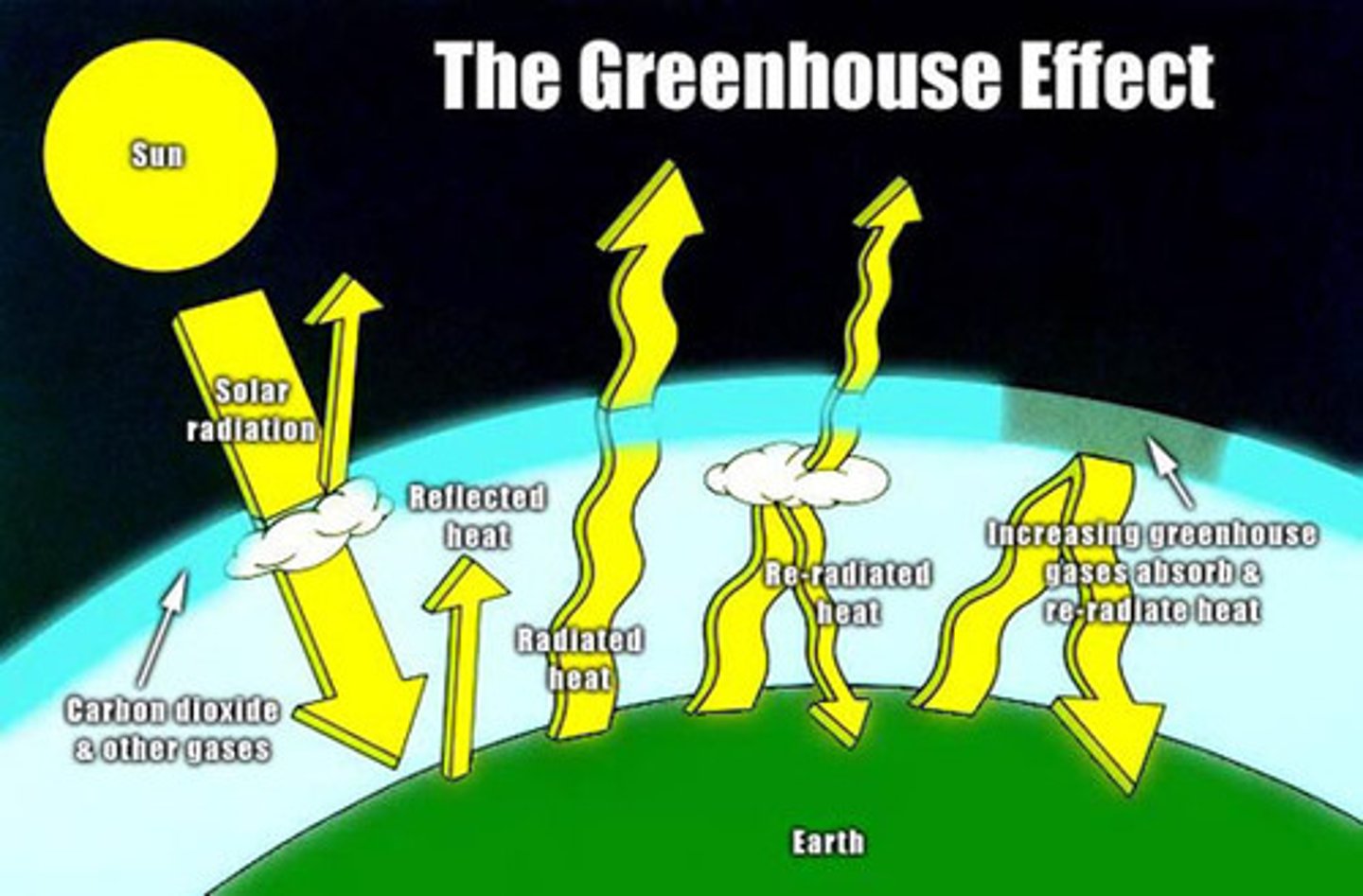
human activities + greenhouse effect
= human activities have been increasing the % of CO2 in the atmosphere since European Industrial Revolution (18th century)
... increase in combustion of fossil fuels releases CO2 that has been locked underground for millions of years in a very short time span, upsetting natural greenhouse effect
... amount of CO2 in atmosphere is increasing, more solar radiation trapped, earth's surface temperature increasing
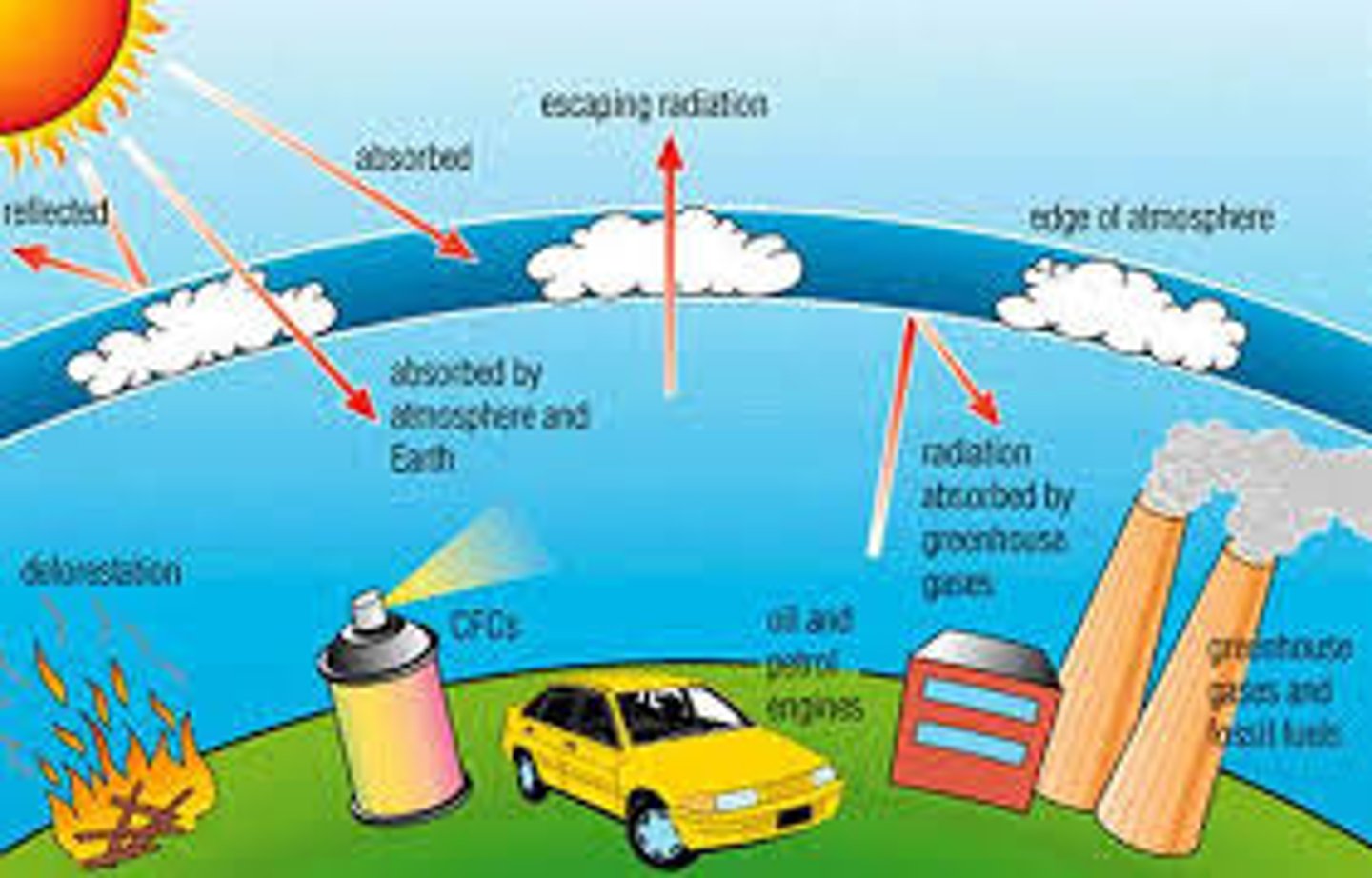
Slow carbon cycle
= takes millions of years
... involves the lithosphere store and the flow into the atmosphere store
- carbon is built up over millions of years in the laying down of sedimentary rocks and ocean sediments
- CO2 slowly released from marine deposits, the weathering of sedimentary rocks and transportation by rivers, or vented via volcanic activity
- time scale is measured in thousands or millions of years
... biosphere to lithosphere/geological store of carbon to atmosphere
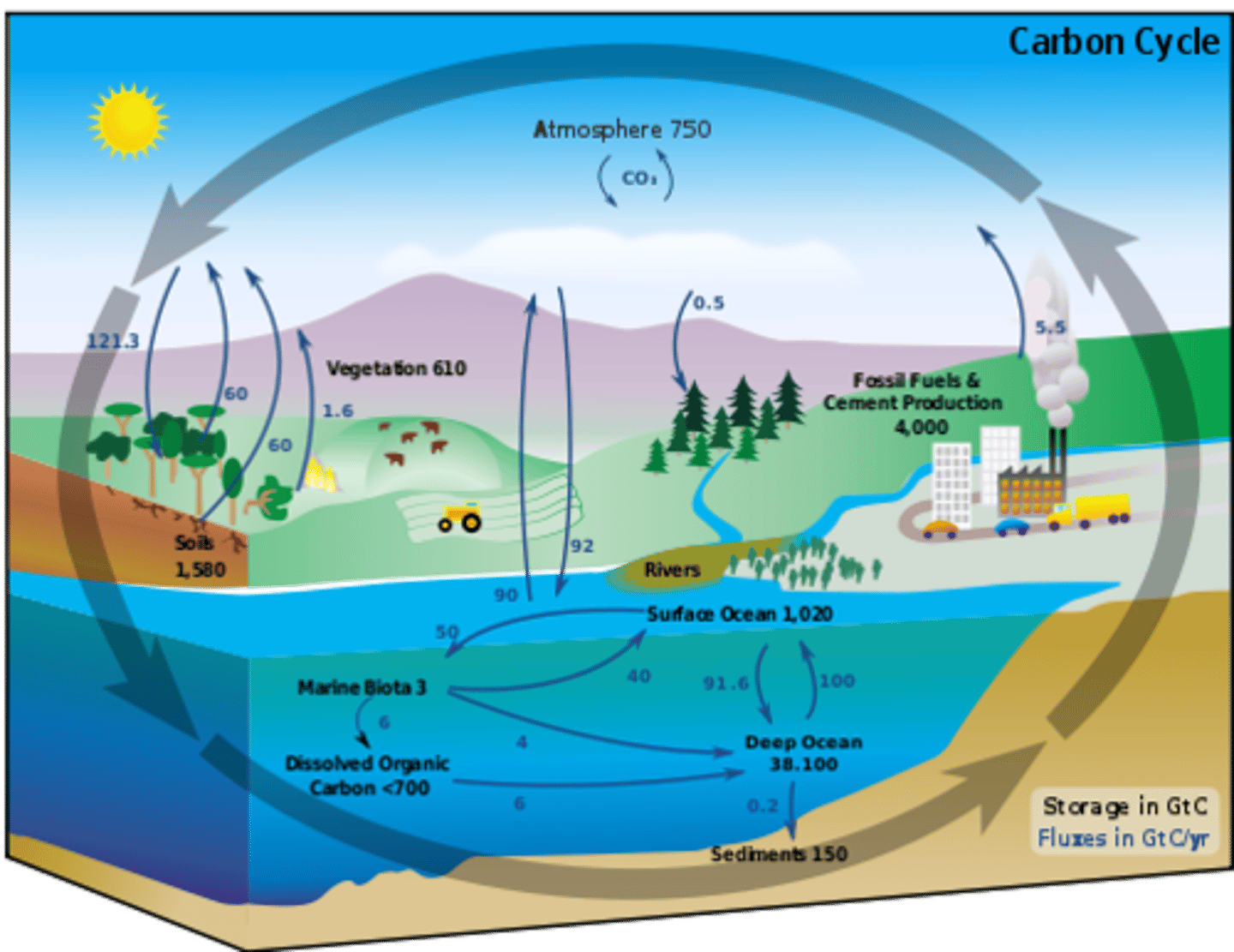
Fast carbon cycle
= the movement of carbon through food chains and takes place within a lifetime
- photosynthesis and the take up of carbon dioxide from the atmosphere can just take a few minutes and within seconds the plant can be giving off CO2 in respiration
- estimated that movement of carbon through food chains is up to 100,000 million metric tons a year
...biosphere/pedosphere to atmosphere/hydrosphere
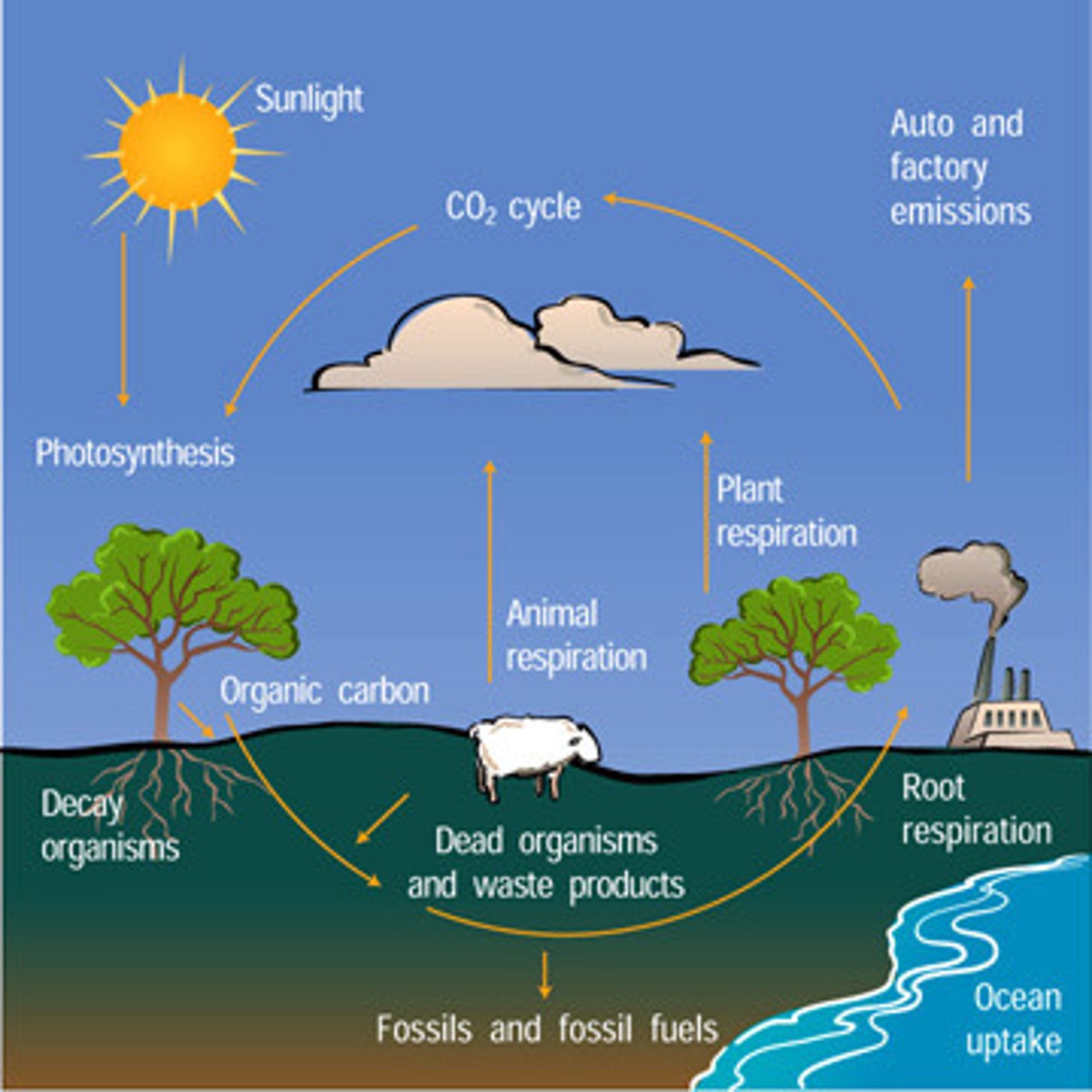
Carbon Budgets
the allocation of carbon to different components of an ecosystem or organism
Carbon Budgets + global trends
1. North America carbon budget is not an equilibrium
... continent is responsible for 25% of global carbon dioxide emissions
- partially due to vehicle fuel in countries like the USA where public transport is limited and people expect to have the freedom of their own car
2. electricity and heating/cooling releases CO2 (created from fossil fuels)
3. traffic jams + increased vehicle use in NEE's (India, China)
- worldwide sales of cars with combustion engines increasing + coal/oil power stations
4. clearance of more land for agriculture means less carbon stores available, carbon budget does not balance
net productivity
Net Primary Productivity (NPP) is the total biomass fixed in an ecosystem/unit area/year
... it is measured as a change in mass of carbon per unit area per year (gC/m2/yr)
... though NPP could also be viewed as a carbon flux because it is the rate of carbon being fixed into the ecosystem
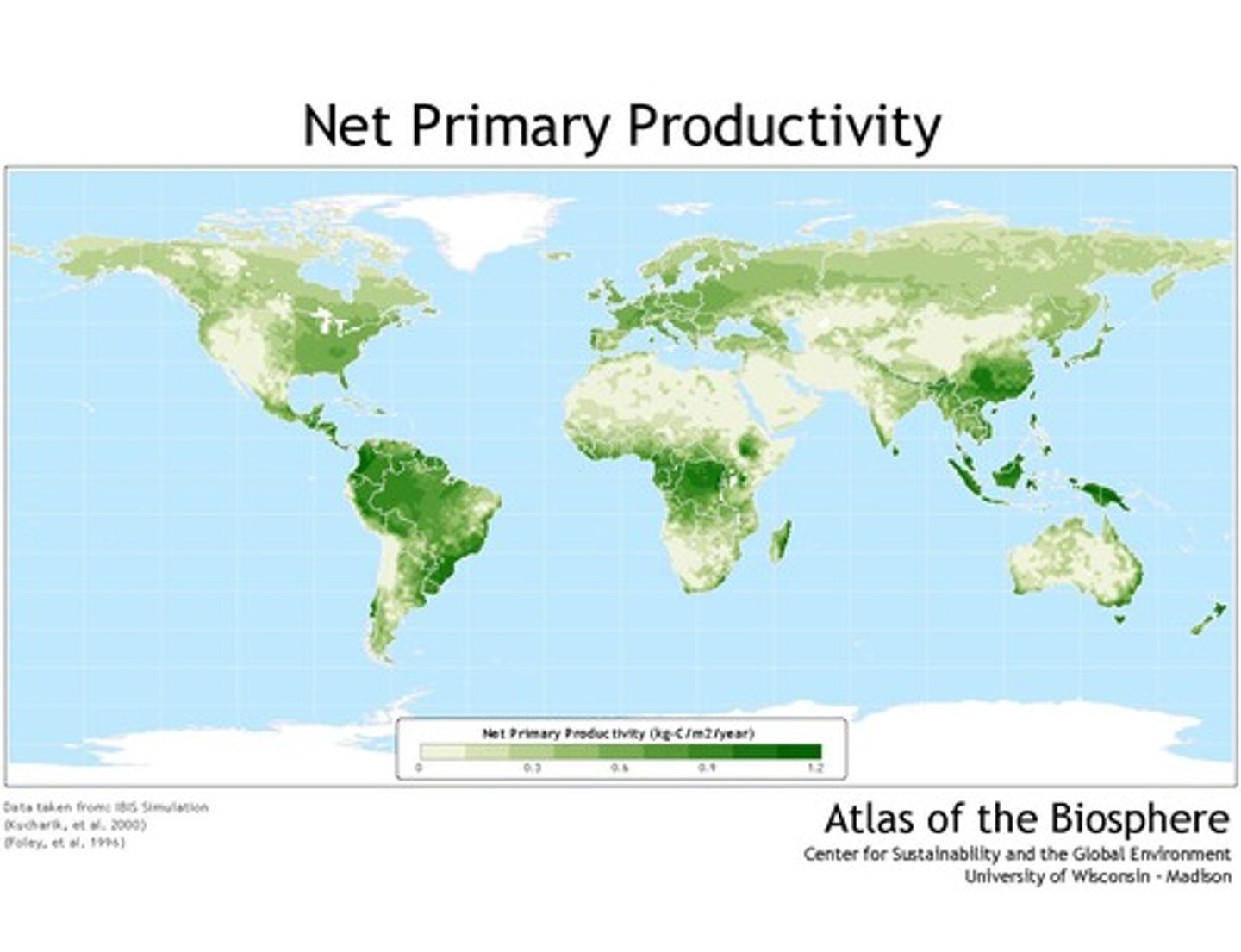
Terrestrial NPP
... based on traditional biomes
- patterns are based on the environment being controlled by purely natural climatic and ecological processes
- can also be affected by human modifications to process
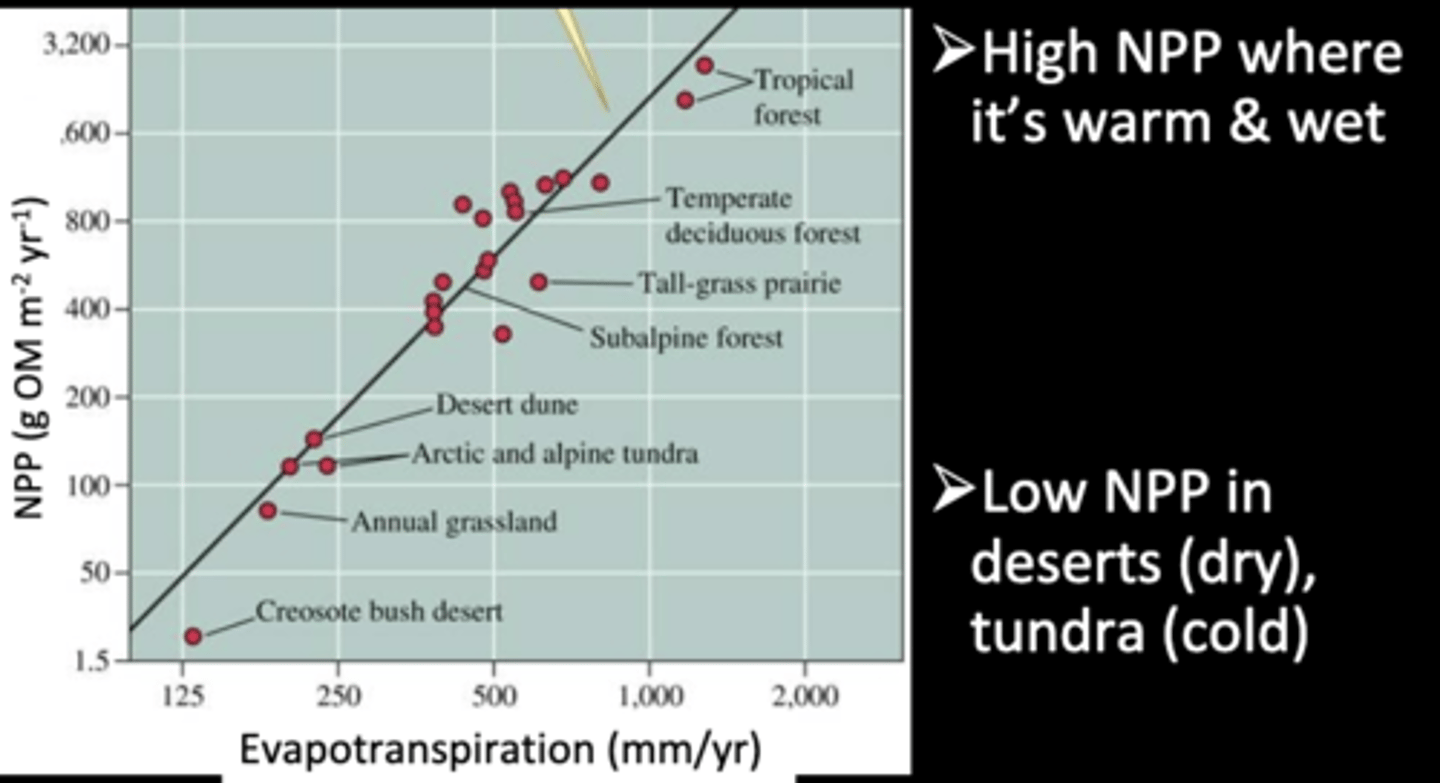
Anthropegenic biomes
main processes involve converting land for agricultural use
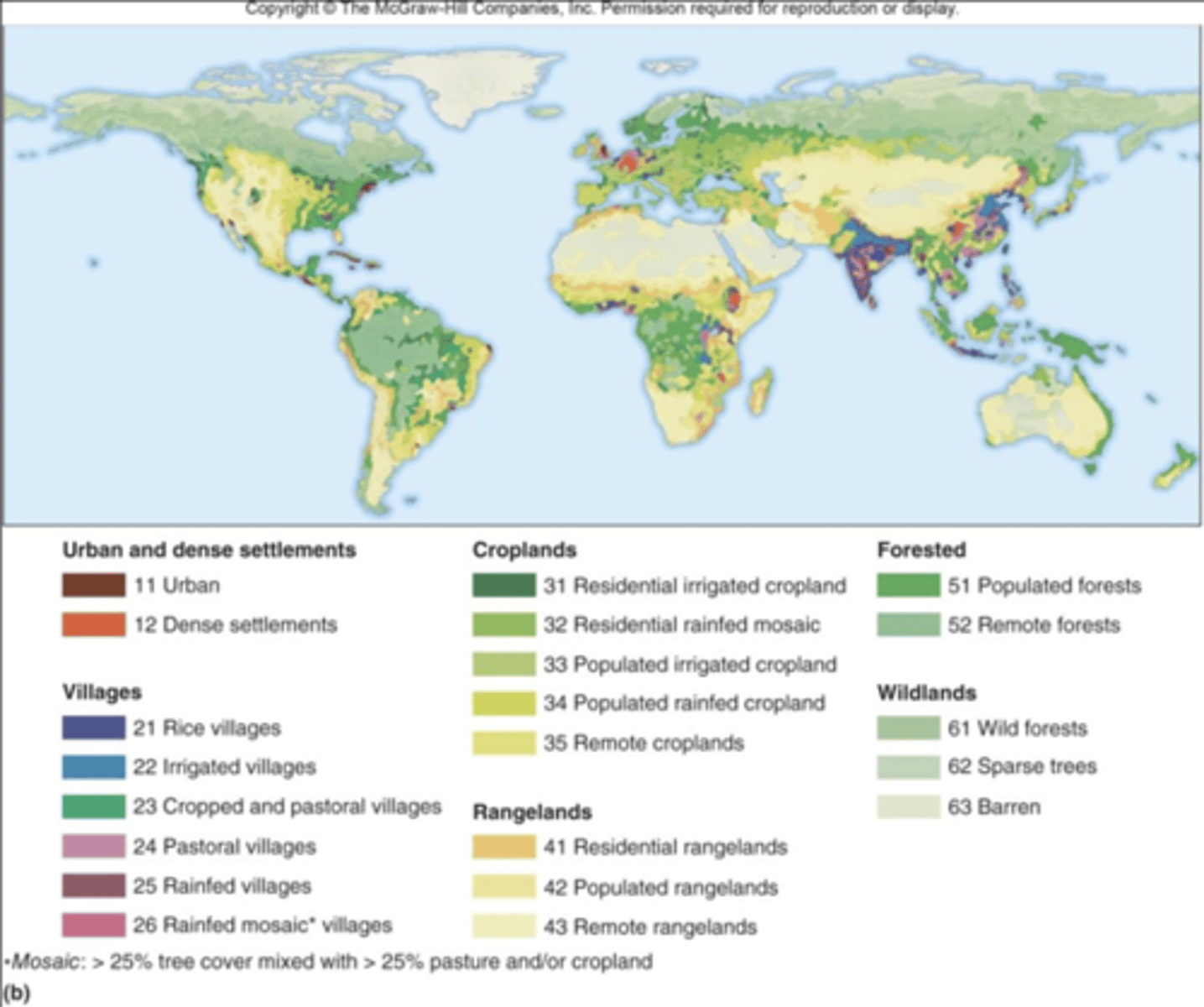
NPP in oceans
NPP varies within oceans
Dark blue = only surface level photosynthesis
Coastal areas = hotspots, marine life is producing a lot of carbon, global marine productivity + most biologically productive areas on the planet, high net productivity
e.g., UK, hotspot for marine productivity of carbon
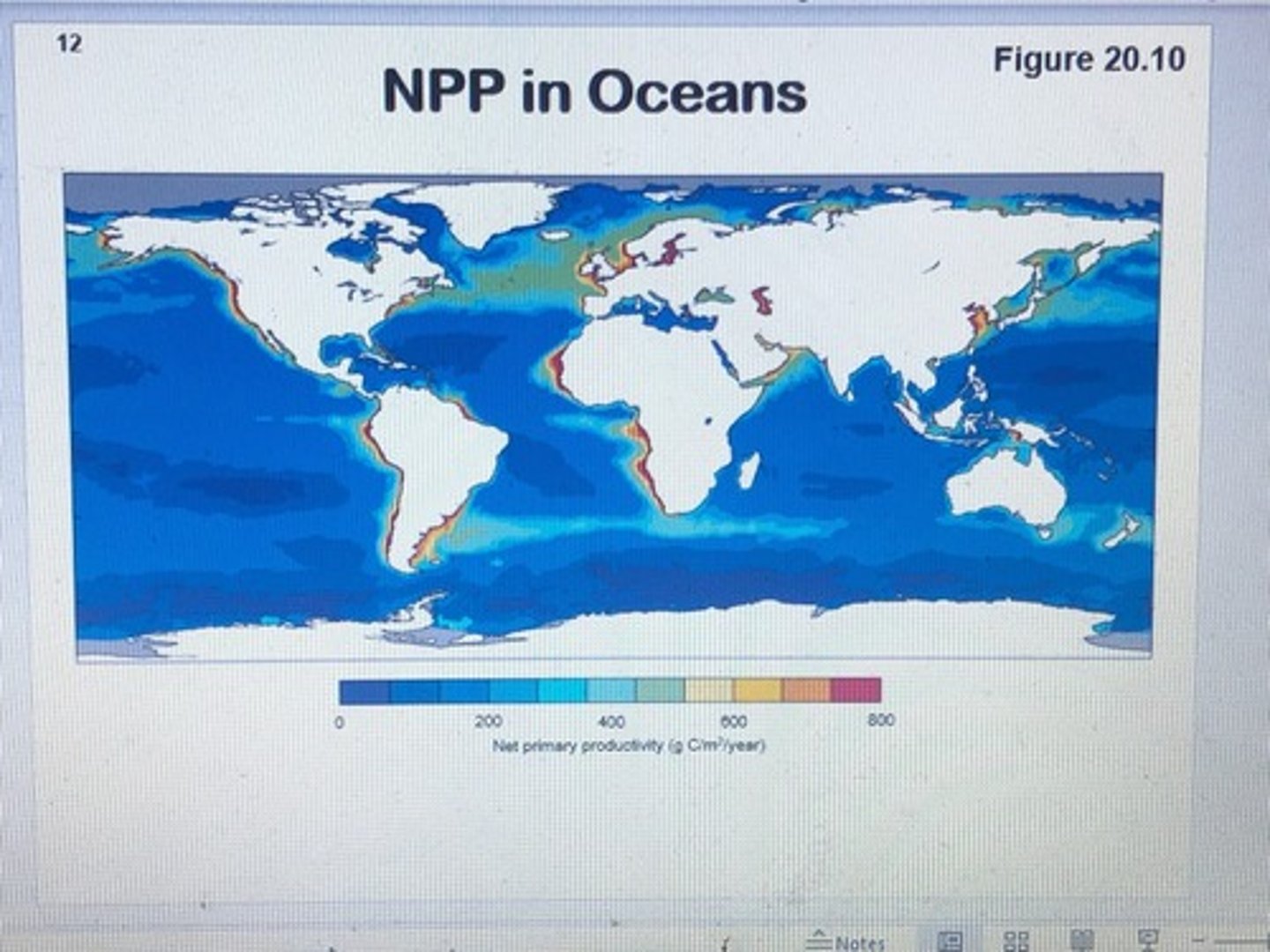
Coral reefs as carbon store
extremely productive despite low coverage of earth's surface
the ocean as a carbon store
Open ocean absorbs more carbon than all rainforests combined
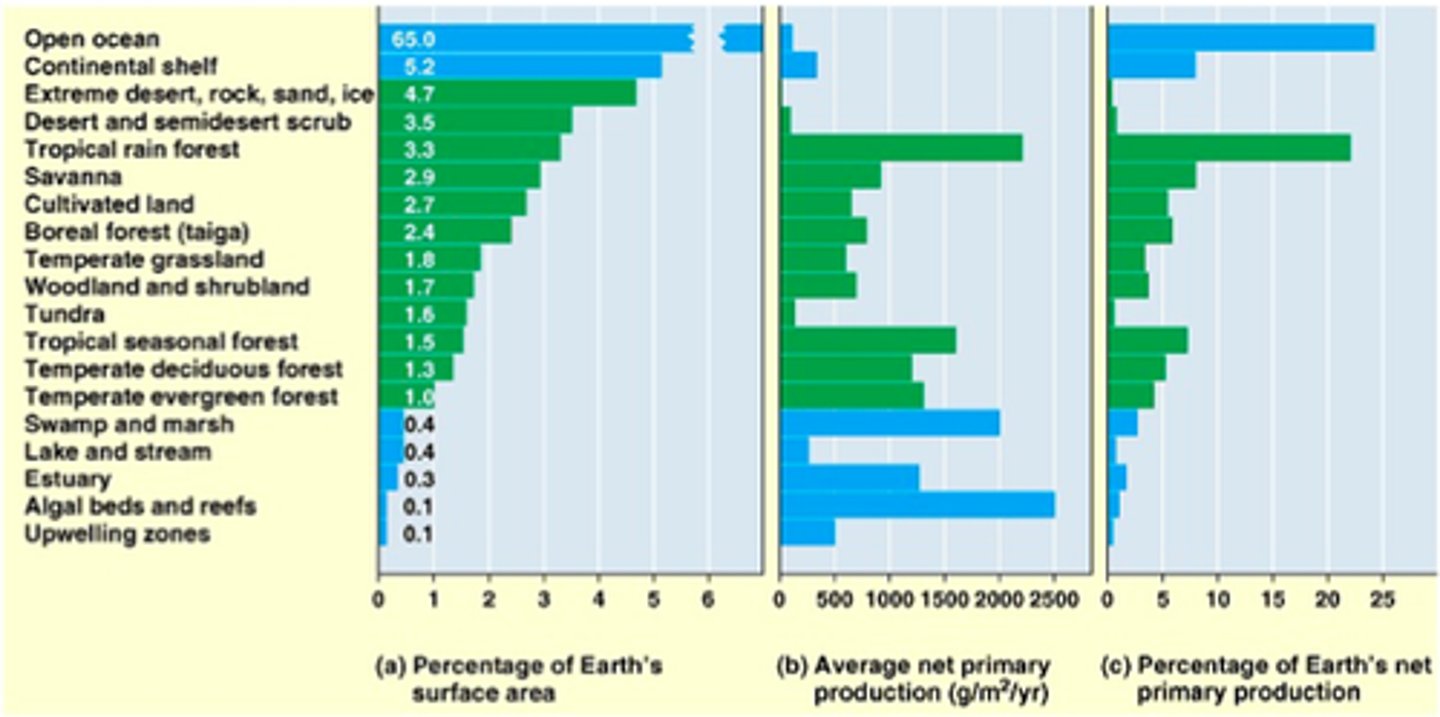
The Carbon Cycle of a Tree
1. Atmospheric carbon is fixed by trees (photosynthesis)
2. Some carbon is transferred from stems, branches, and foliage stores to below ground carbon stores (roots, litter)
3. Some carbon is transferred from belowground carbon to the soils
4. Fallen leaves and branches add to this carbon in the soils as it is decomposed by decomposers, returning carbon to ground as dead organic matter
5. Carbon is lost to the atmosphere through soil respiration and respiration from the tree itself
FAST
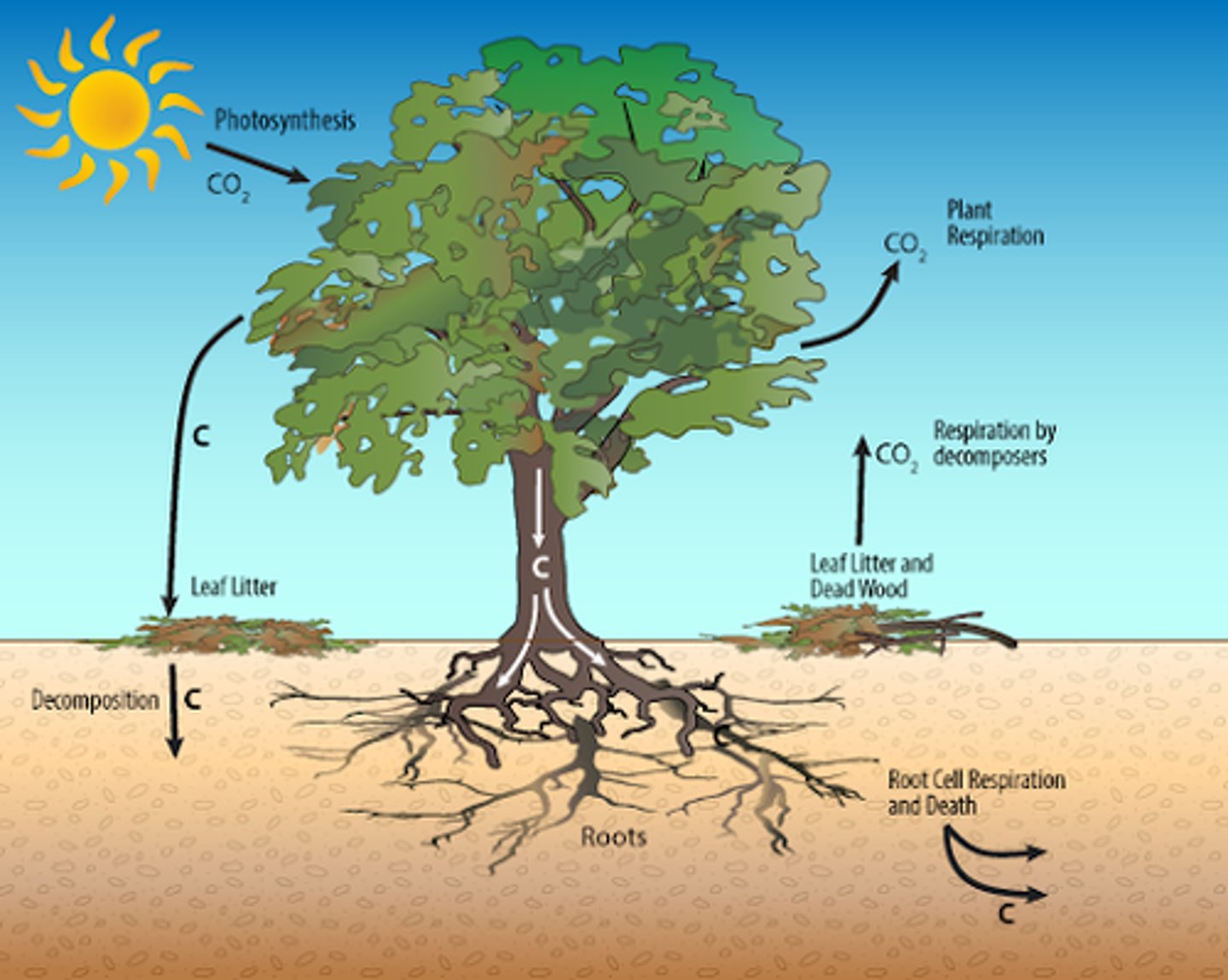
CO2 uptake and climatic climax
in Panama and Brazil, trees of a number of different species have been shown to live for nearly 1,500 years
... at 100 or so years of age, these high up taking CO2 trees use more CO2 than older trees, and their appetite diminishes as it gets older
- Chambers (1998): long-lived trees of Brazil continue to experience protracted slow growth even at 1400 years of age, and the protracted slow growth of very old and large trees can absorb a huge amount of CO2 out of the air each year
(especially in the central Amazon)
- About 50% of above ground biomass in the amazon is contained in less than the largest 10% of trees
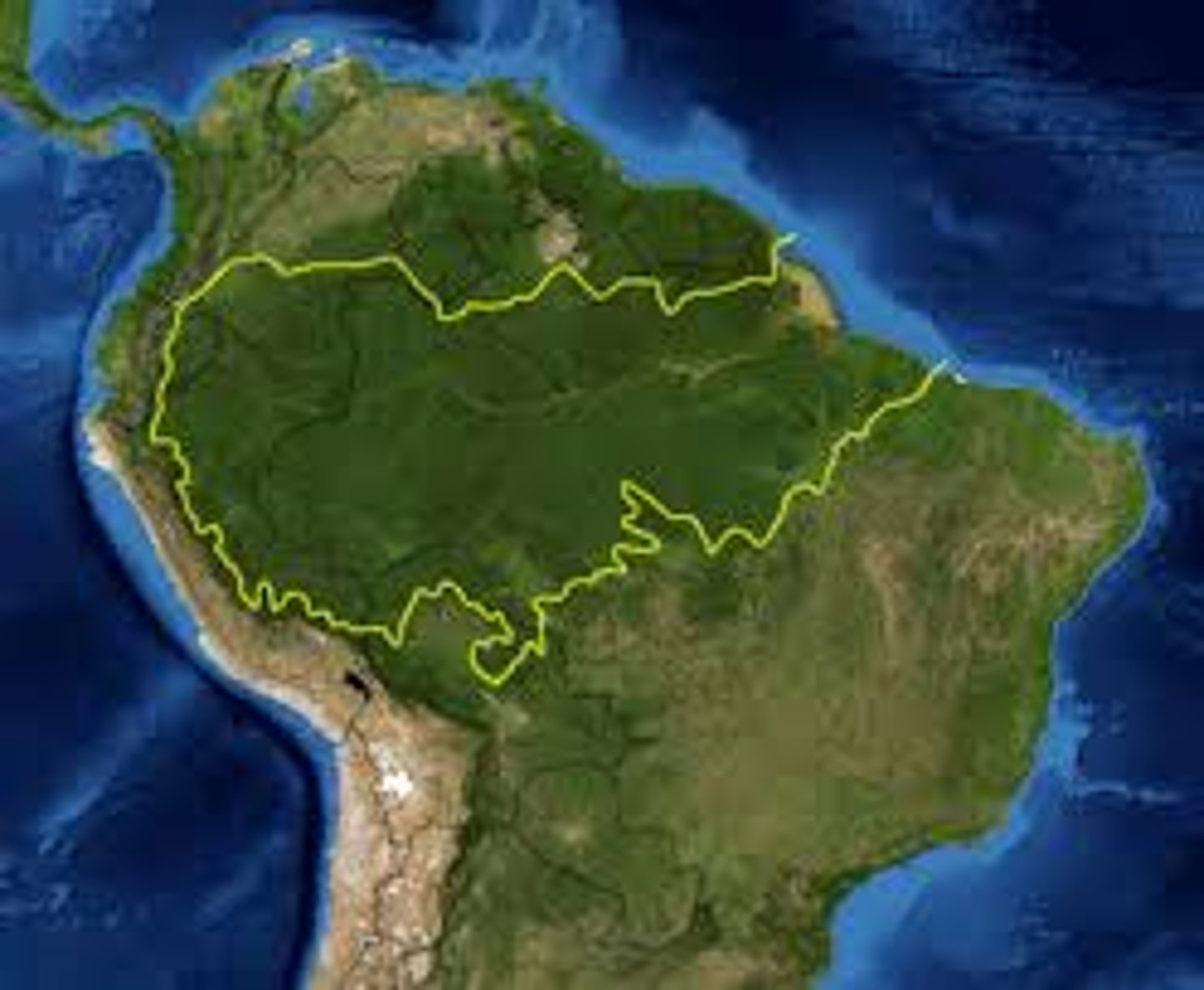
short term carbon cycle
... process powers all life as carbon moves through food chains and ecosystems from organism to organism
FAST carbon cycle
1. Diffusion
2. Photosynthesis
3. Respiration
4. Decay/Decomposition
5. Feeding/Consumption
6. Methane Formation
7. Combustion
1. Diffusion
= net movement of particles from an area of high concentration to an area of low concentration
... carbon moves between the ocean's surface and the atmosphere via diffusion
FAST
2. Photosynthesis
= process by which plants use sunlight, water, and CO2 to create O2 and energy
... autotrophs, make its own food for growth, repair, and reproduction
- Plants "fix" carbon from the air during photosynthesis so that it can be used in areas of the plant to make organic compounds
e.g., glucose
- This glucose can then be consumed by consumers and passed through food chains, passing the carbon along in the FAST carbon cycle
- Carbon is fixed in excess which allows it to be passed through the food chain and provide more biomass for transference
NPP = rate of photosynthesis
(net primary productivity)
FAST
Photosynthesis equation
6CO2 + 6H2O --> C6H12O6 + 6O2

3. Respiration
= the biochemical process in which the cells of an organism obtain energy in the form of oxygen and glucose and release CO2, water, and ATP
... Carbon is released from organisms in the process of exhaling, transferring it back to the environment
- Plants and animals
- Photosynthesis and respiration are NOT balanced
... not all organic matter is oxidised, some is buried in sedimentary rocks
... more O2 has been released by photosynthesis than CO2 by respiration
FAST
Respiration Equation
C6H12O6 + 6O2 --> 6CO2 + 6H2O + ATP ENERGY
4. Decomposition/Decay
= the physical, chemical, and biological mechanisms that transform organic matter into increasingly stable forms
... Physical wet/dry, heat/cool, shrink/swell cycles
- Biological feeding and digestion is aided by enzymes and bacteria
- Carried out by decomposers eg saprobionts
- Decomposition ensures a flow of nutrients into the pedosphere which sustains the producers
... break down dead organisms into dead organic matter, returning carbon to soils/atmosphere via respiration
FAST
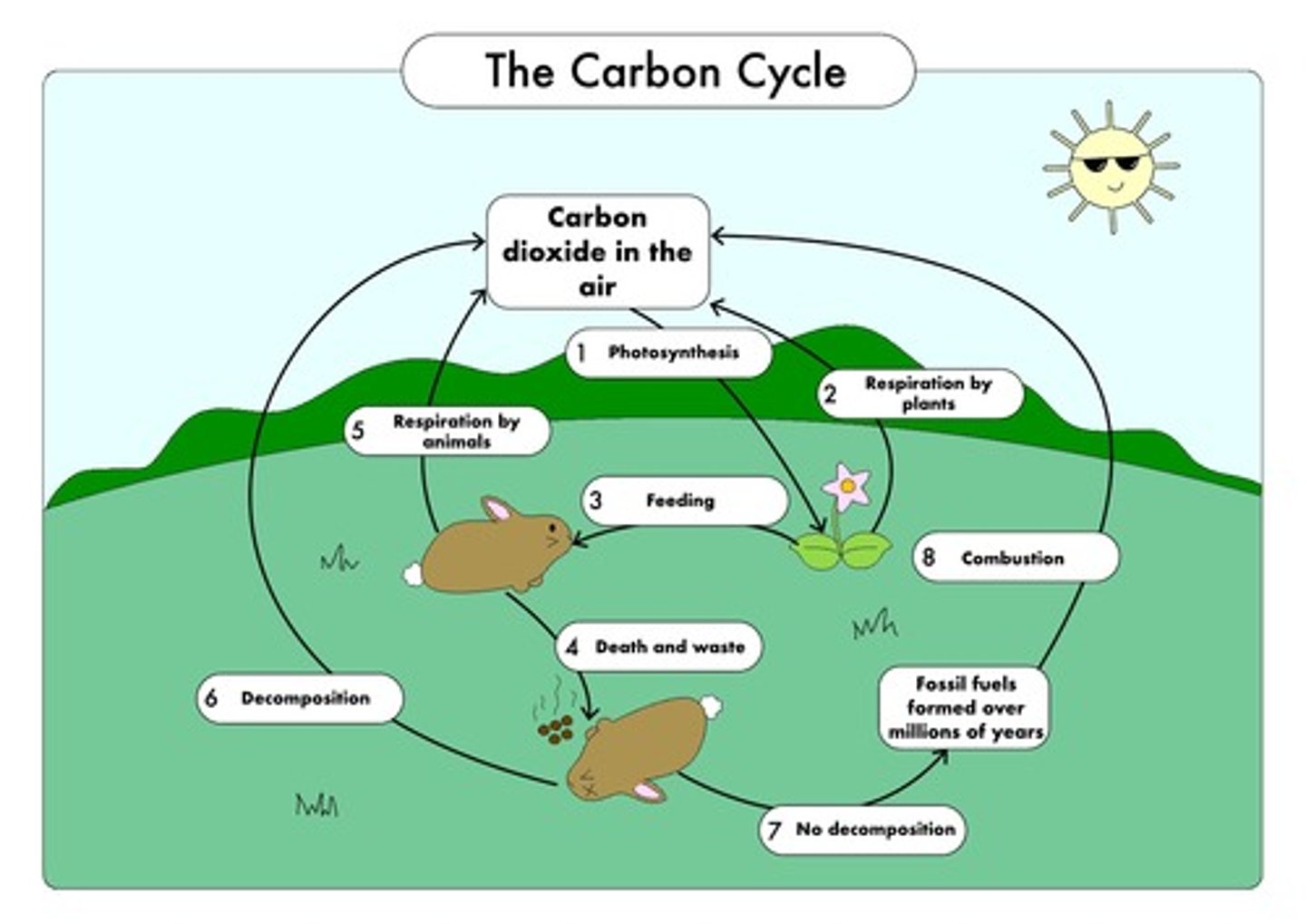
soil type + decay/decomposition
= Soil type plays a role in the respiration and decomposition of dead organic matter
i.e., more active respiratory soils around the equator
... more fertile soils/higher temperatures/higher rainfall for growth of plants, more dead plants for decomposers to break down, more dead organic matter returned to soils, more respiration of soils so more CO2 emitted
5. Feeding/Consumption
Carbon dioxide is absorbed by producers to make glucose in photosynthesis
Animals feed on the plant passing the carbon compounds along the food chain
... most of the carbon they consume is exhaled as CO2 that was formed during aerobic respiration
FAST
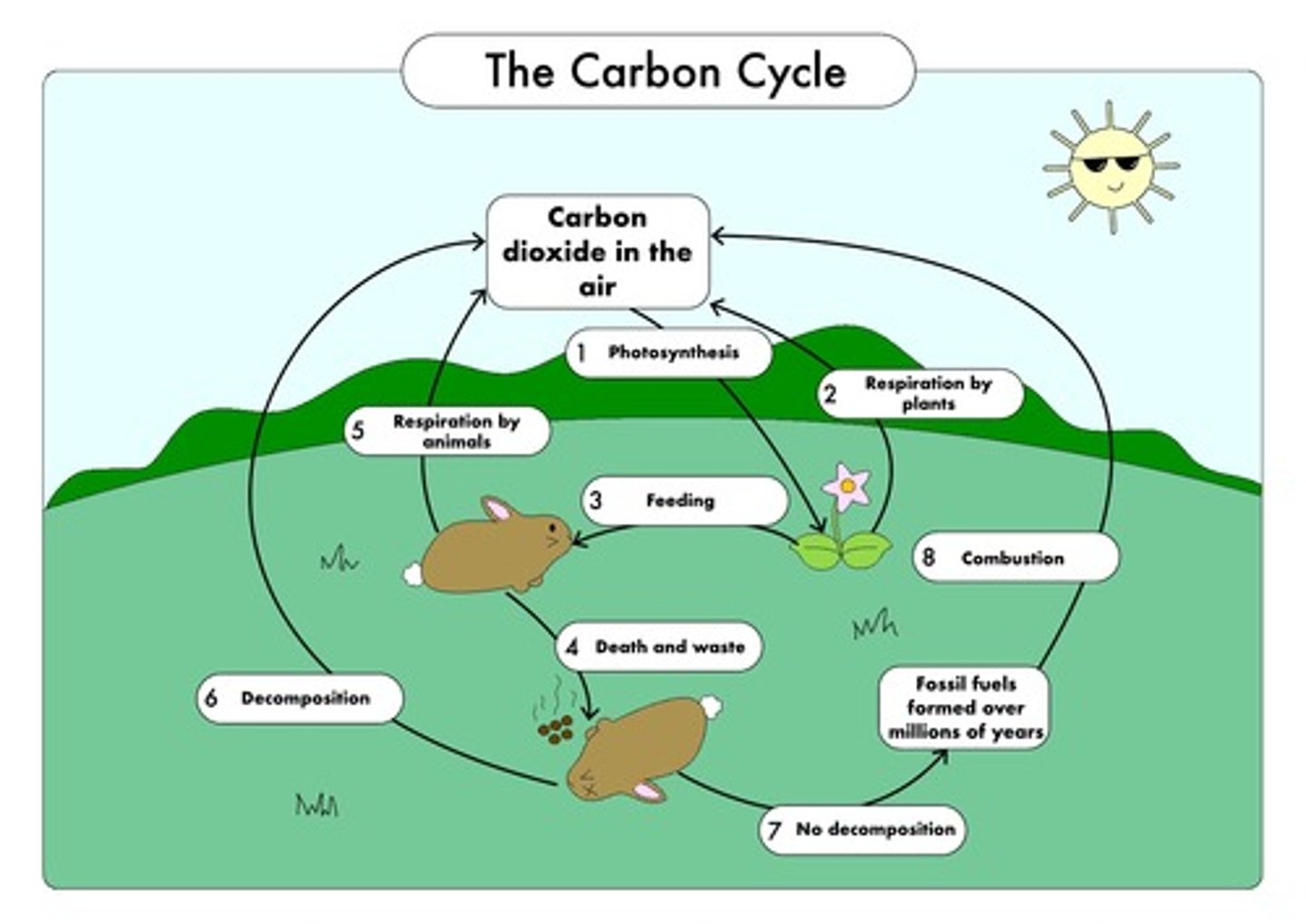
6. Methane Formation
(in anaerobic marshland)
= prevailing anaerobic conditions in wetland soils slow down or suspend decomposition processes of organic matter
... these processes are connected with the production of methane (CH4) and carbon dioxide (CO2)
- Wetland habitats are filled with waterlogged soils and permafrost, making them sizeable carbon sinks
- Warming climate causes wetland soils to warm of flood, carbon is released into the atmosphere as methane
FAST
chat gpt
Special microbes take over:
In the absence of oxygen, methanogenic archaea (a type of microorganism) step in.
These microbes break down organic matter in a different way — not via anaerobic respiration, but through a process called methanogenesis.
Methanogenesis produces methane:
These archaea use carbon compounds (like CO₂ or acetate) and produce CH₄ (methane) as a byproduct.
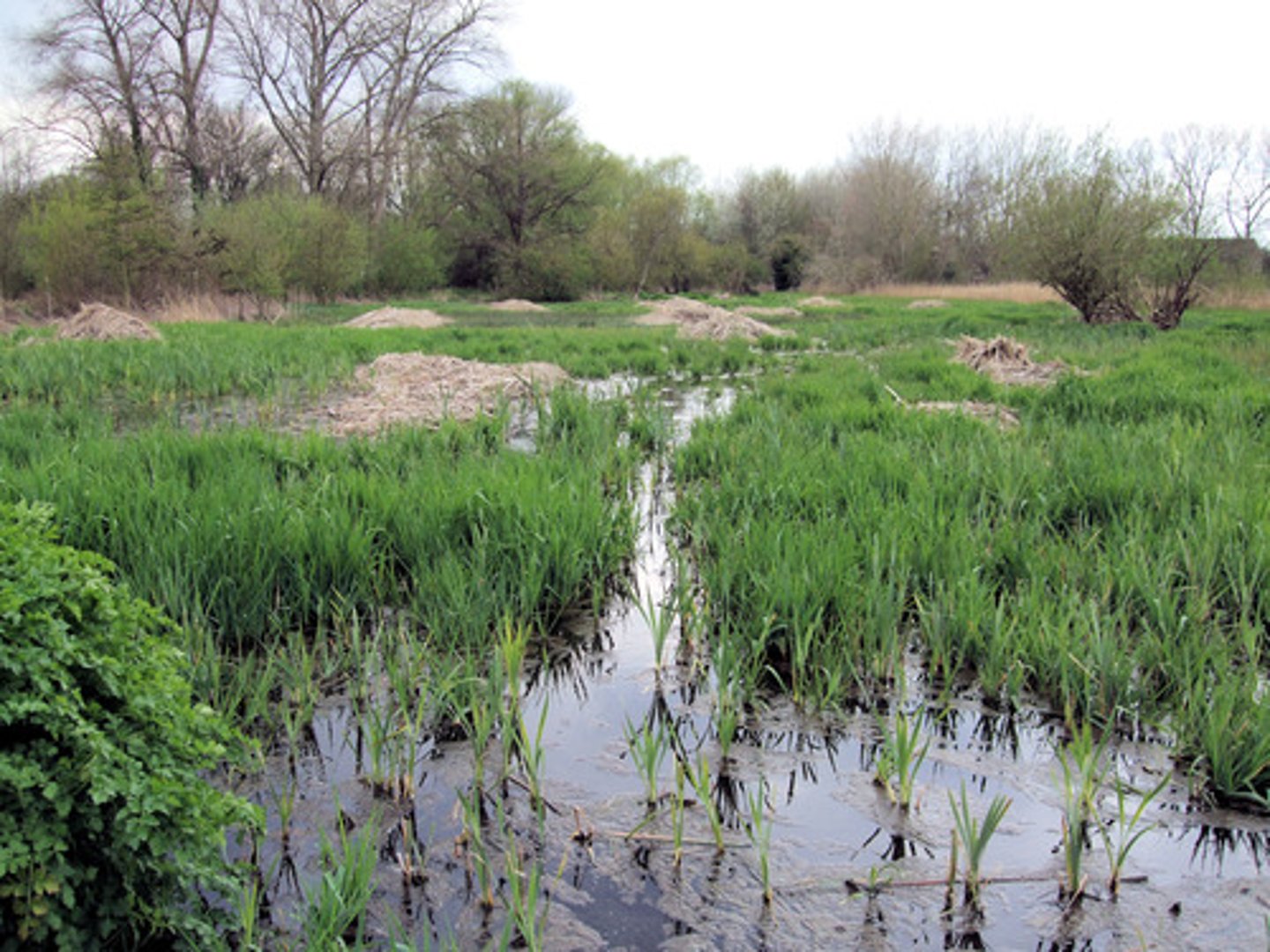
6. Combustion
= organic material is burned in the presence of oxygen to release CO2, H2O, and energy
- Biomass combustion is the burning of living and dead vegetation, mostly human induced
- Every year, fires burn 4 million Km2 of the Earth's land surface, releasing > 1 billion tonnes of CO2
- Fires can stimulate rapid re-growth and carbon sequestration
... Carbon released back into the atmosphere
--> Volcanic eruptions
= when volcanos erupt, they vent the gas to atmosphere
- CO2 returned to atmosphere in extremely large amounts
... emit between 130 and 380 million metric tonnes of CO2 a year
FAST
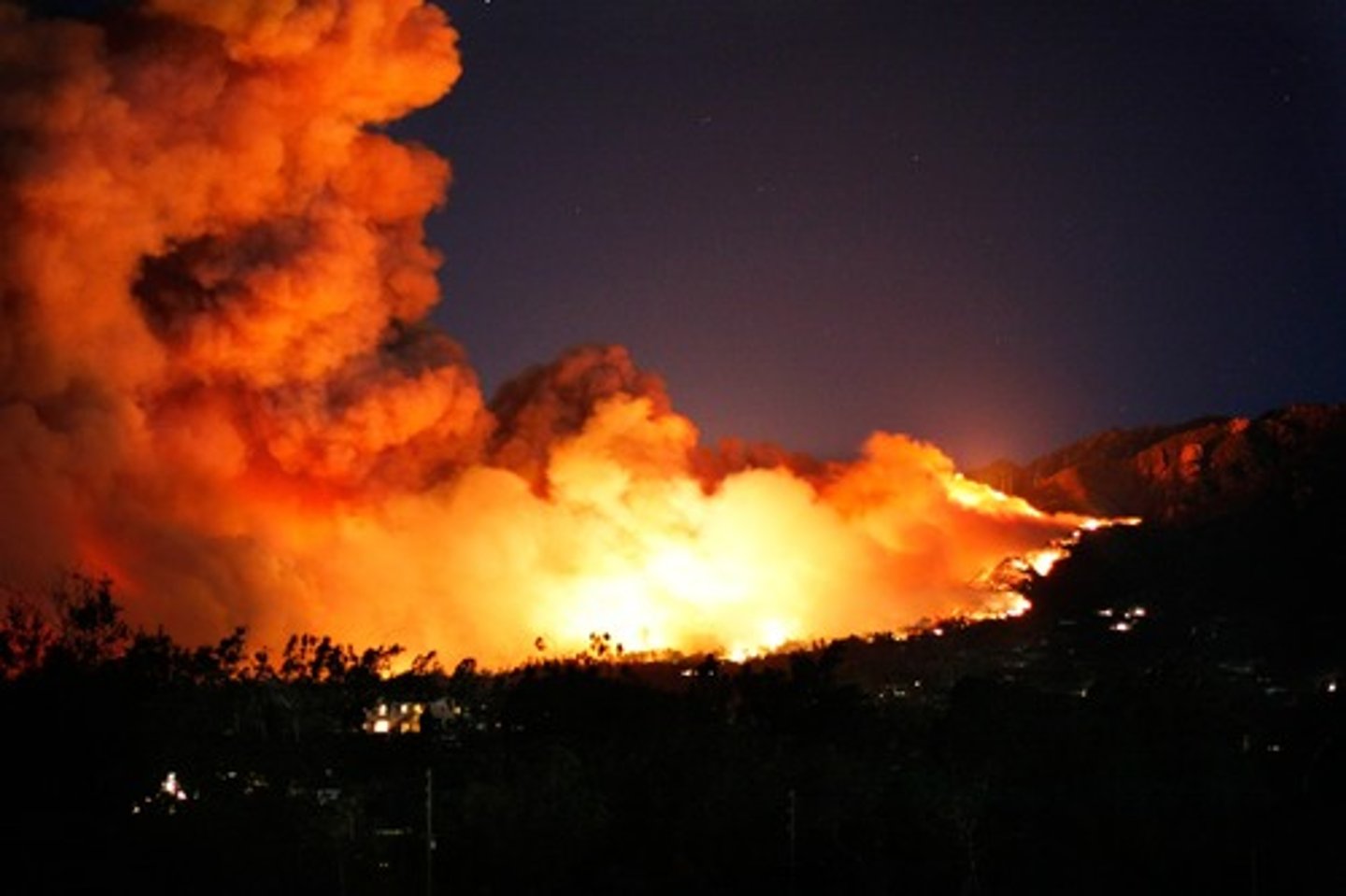
Compaction - burial and compaction
where organic matter is buried by sediments and becomes compacted
over millions of years, these organic sediments containing carbon may form hydrocarbons such as coal and oil
corals and shelled organisms take up CO2 from the water and convert it to calcium carbonate to build their shells
when they die the shells accumulate on the seabed
... some carbon dissolves, releasing CO2
... the rest becomes compacted to form limestone, storing carbon for millions of years
long term carbon cycle
... takes 1-2 million years for carbon to move through it
SLOW carbon cycle
1. carbon sequestration
2. chemical weathering (carbonation)
3. shell and coral formation
4. peat formation
5. fossilisation
1. Carbon Sequestration
Carbon Sequestration in the oceans and sediments
- the Ocean Carbon Pump
- CO2 is dissolved into oceans
1. it is converted into organic and inorganic matter to be recycled and returned to the atmosphere via deep-water circulation and upwelling
Or
2. Inorganic carbon is converted into sedimentation as Carbonates or organic carbon compounds,
... marine organisms respire and release CO2 back into atmosphere at same time
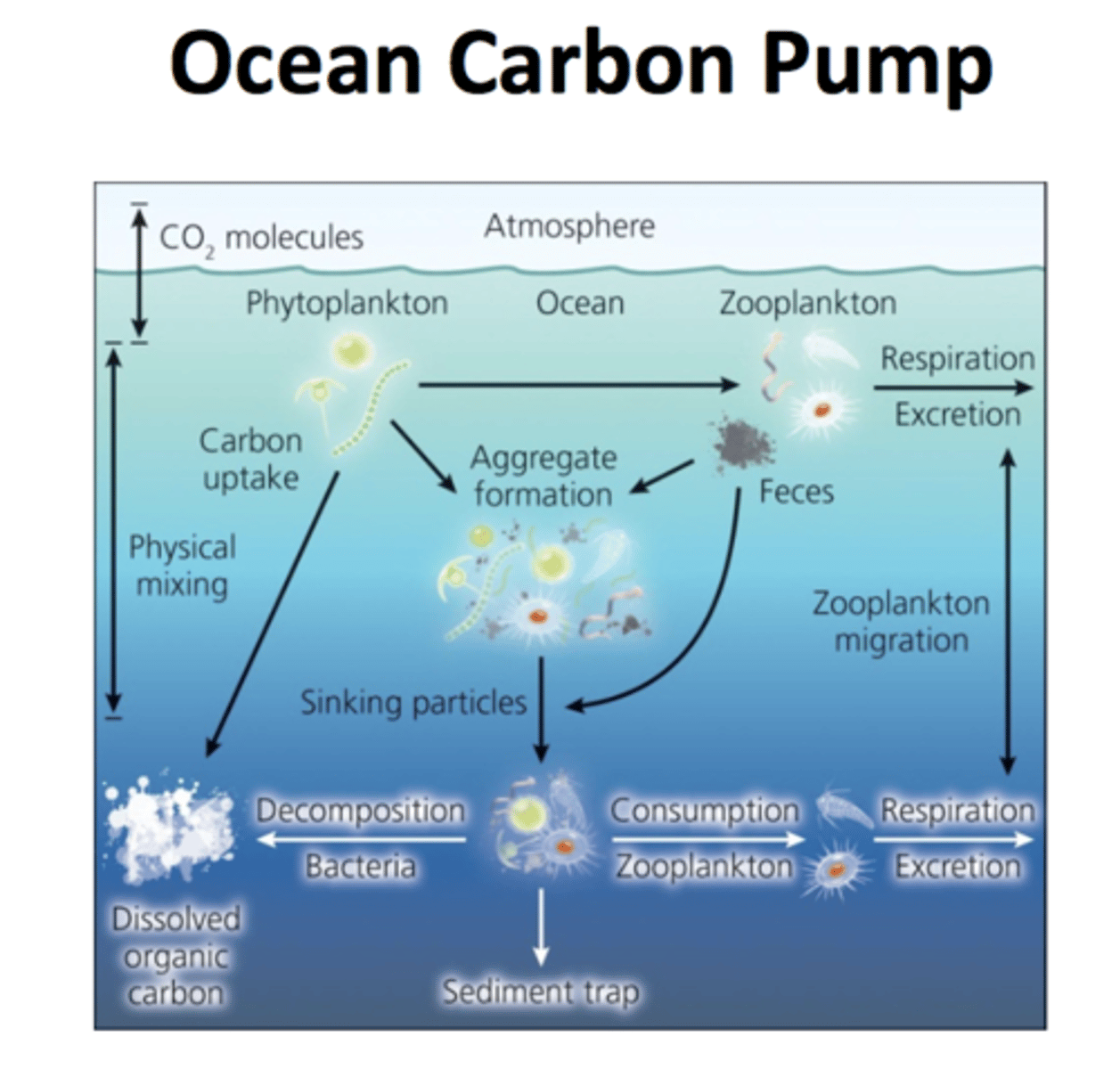
Positive Feedback + Carbon Sequestration
Positive feedback effects of oceanic warming
... oceans absorb CO2, causes initial warming
- More ice melts and more open water
- Reduces albedo effect so more radiation is absorbed (causes increased temperatures)
- More water in ocean absorbs more heat
- More CO2 absorbed
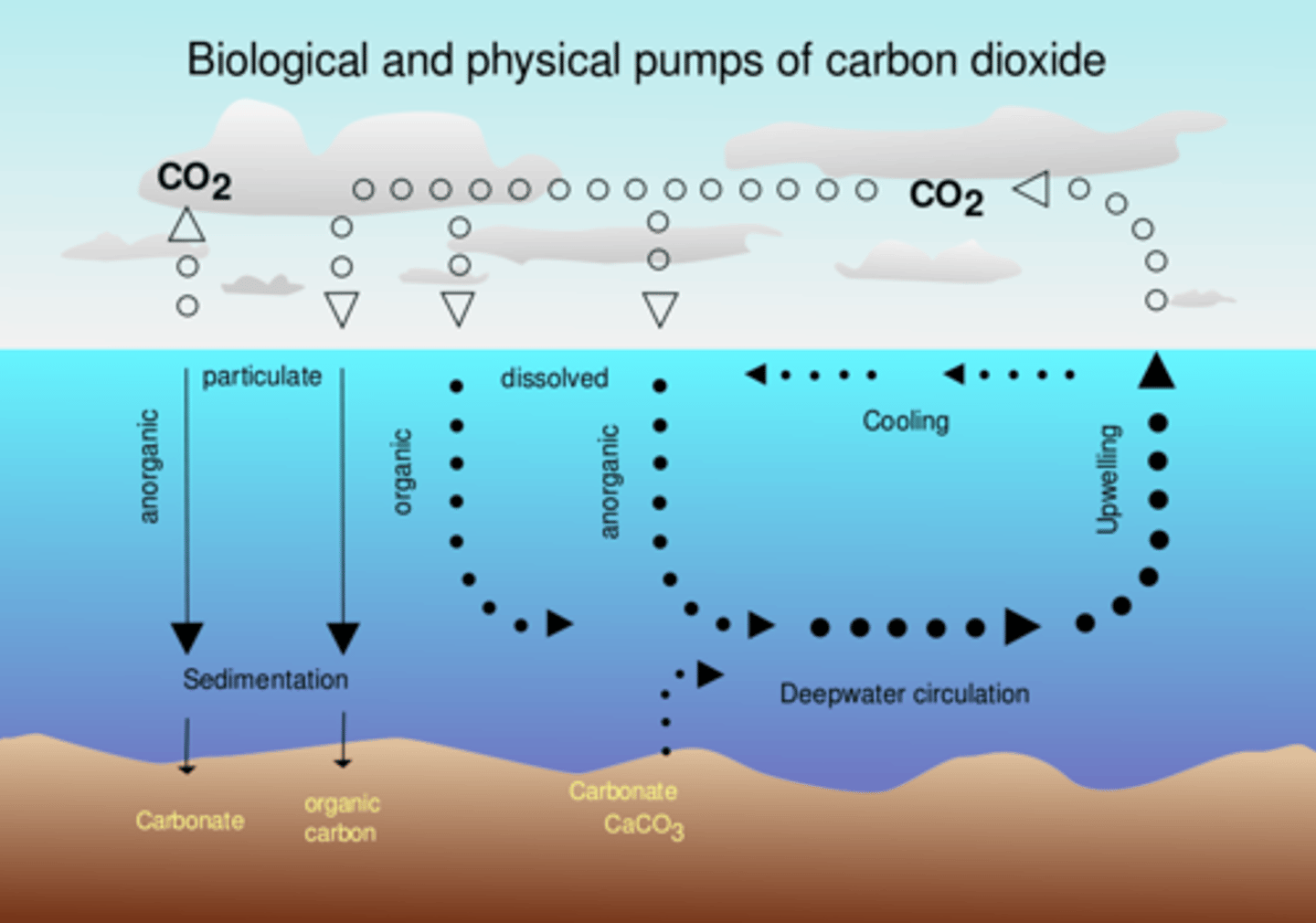
2. Chemical Weathering
(Carbonation)
Global atmospheric CO2 consumption by chemical weathering
... carbon bicarbonate dissolved in river water which eventually drains into the sea and enters the ocean carbon pump
- Atmospheric carbon combines with water to form a weak acid (carbonic acid) that falls to the surface in rain
- Acid exposes the organic carbon in rocks to O2 in the air and water, so that it reacts to form CO2 which is released.
- The acid dissolves rocks (chemical weathering) and releases calcium, magnesium, potassium, or sodium ions (runoff into water)
SLOW
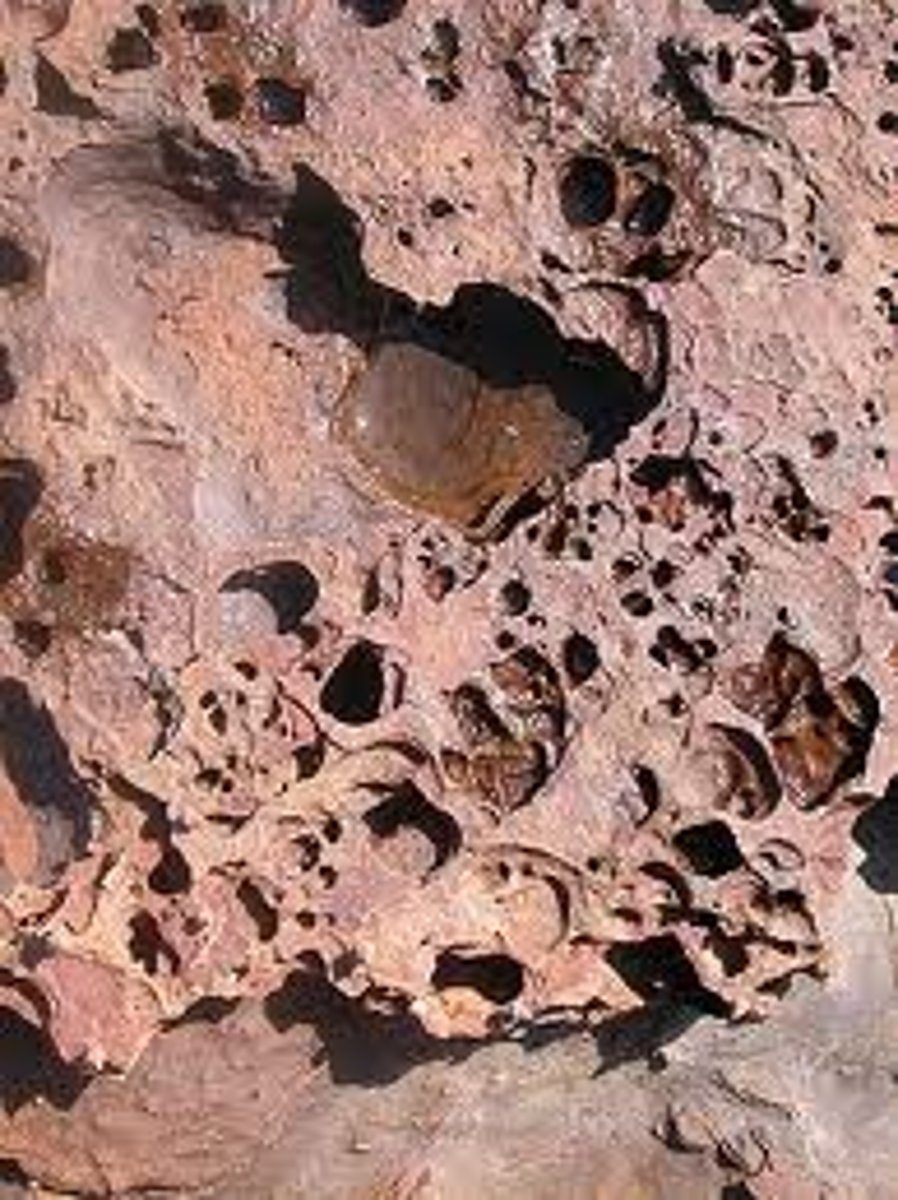
3. Shell and Coral Formation
(sedimentary rocks)
CO2 dissolves in oceans and reacts with water from carbonic acid
Carbonic acid reacts with carbonate ions in the water to form carbonate and hydrogen ions
Carbonate ions combine to form calcium carbonate crystals and shell building organisms
e.g., coral need to create shells/skeletons
SLOW
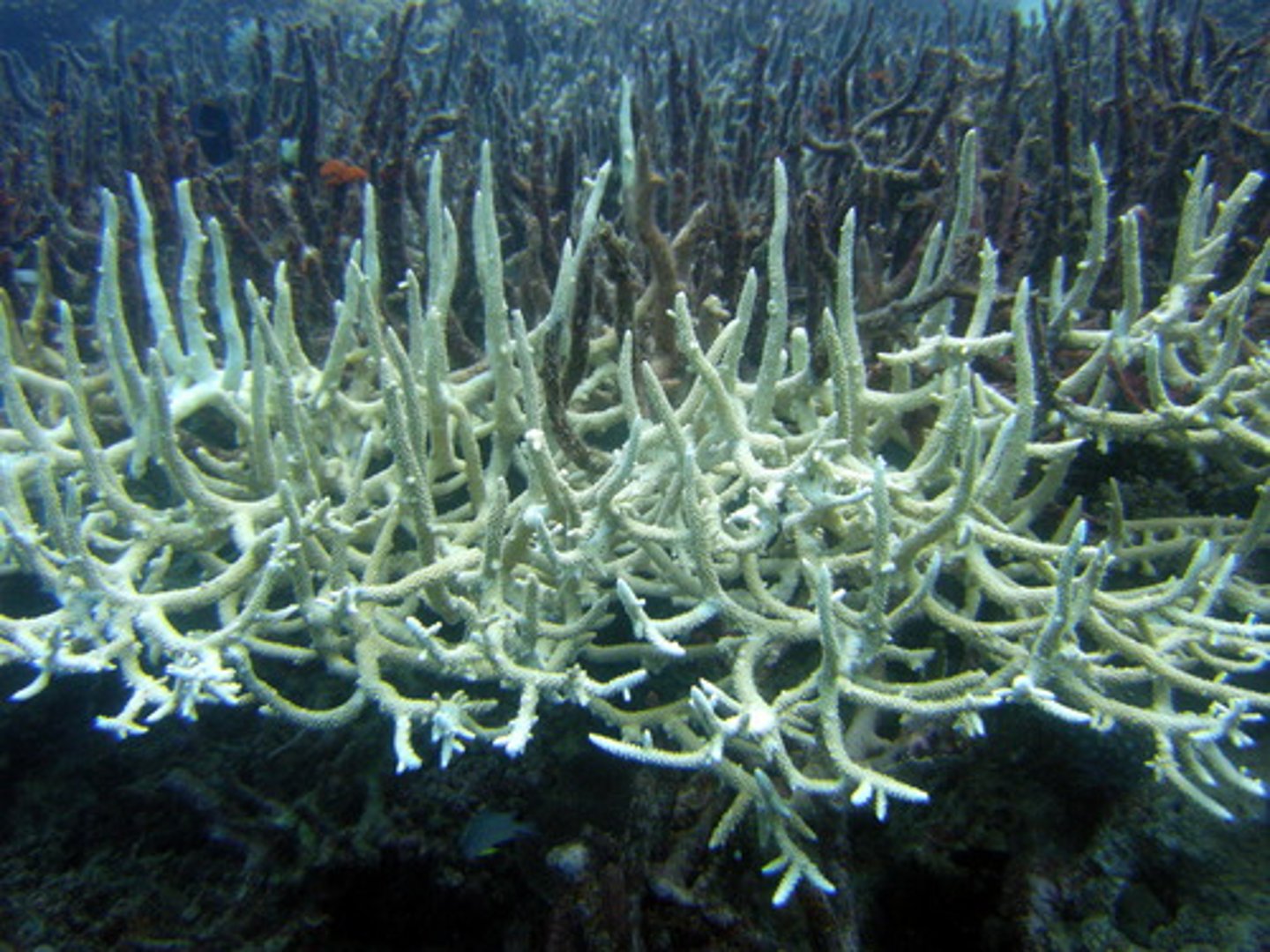
4. Peat Formation
... forms as a result of incomplete decomposition of the remains of plants growing in waterlogged conditions
= living peatland plants capture carbon from the air through photosynthesis and then trap it in the waterlogged, anaerobic conditions
--> act as carbon sinks
--> SLOW carbon cycle, can take 1,000 years to form
... draining water away from peat makes it dry out, so air penetrates it and combines with carbon to form CO2 which is released into the air
... burning peat release CO2 into the air, goes from carbon sink to carbon source
SLOW

5. Fossilisation
... when animals die, they decompose, and their remains become sediment
--> trap stored carbon in layers that eventually turn into rock or minerals
--> some sediment might form fossil fuels (coal, oil, natural gas) that release carbon back into atmosphere when fuel is burned
SLOW carbon cycle
